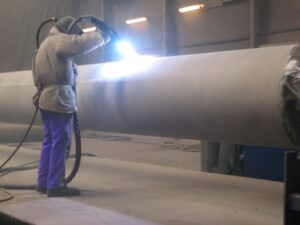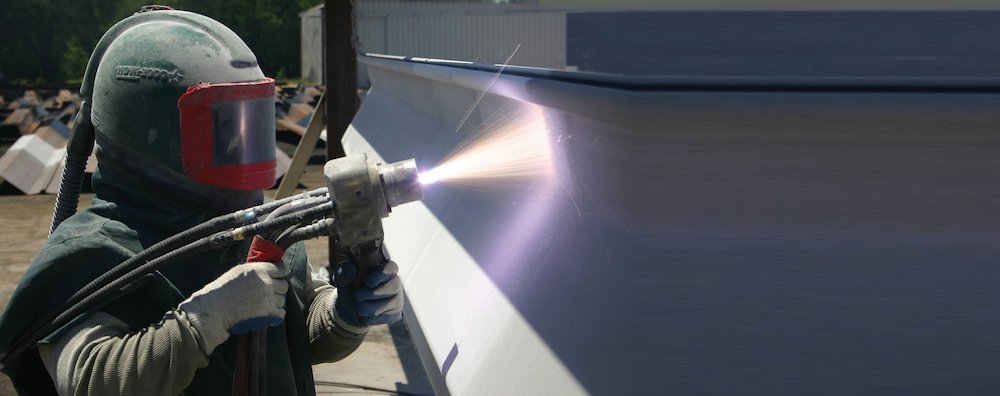Metalizing or thermal spraying is a surface coating process that involves applying a protective layer of molten metal to steel structures to enhance their durability and resistance to corrosion. This technique offers numerous advantages over traditional coating methods, making it a popular choice for various industrial applications.
How Metalizing Works
Metalizing begins with the preparation of the steel surface, which involves cleaning and roughening to ensure proper adhesion of the metal coating. Once the surface is prepared, the metalizing process begins by feeding a metal wire or powder into a specialized spray gun. The wire or powder is then heated to a molten state using a combustion flame or an electric arc.
As the metal material melts, it is propelled onto the steel surface using compressed air or gas, forming a uniform coating layer. The molten metal solidifies upon contact with the substrate, creating a tightly bonded and highly resistant protective layer. This process can be repeated multiple times to achieve the desired coating thickness.
Applications of Metalizing
 Metalizing is widely used in various industries, including marine, automotive, aerospace, and infrastructure. In marine environments, metalizing is often used to protect offshore platforms, ship hulls, and marine structures from corrosion caused by saltwater exposure. In the automotive industry, metalizing is employed to coat automotive components, such as exhaust systems, to enhance their heat resistance and longevity.
Metalizing is widely used in various industries, including marine, automotive, aerospace, and infrastructure. In marine environments, metalizing is often used to protect offshore platforms, ship hulls, and marine structures from corrosion caused by saltwater exposure. In the automotive industry, metalizing is employed to coat automotive components, such as exhaust systems, to enhance their heat resistance and longevity.
In aerospace applications, metalizing is utilized to protect aircraft components from corrosion and wear, ensuring the safety and reliability of aircraft operations. In infrastructure projects, metalizing is commonly used to coat steel bridges, pipelines, and other structures exposed to harsh environmental conditions.
Benefits of Metalizing
Metalizing offers several advantages over traditional coating methods, including:
1. Corrosion Resistance: Metalizing provides superior corrosion protection, particularly in harsh environments such as marine and industrial settings. The dense and uniform coating effectively shields steel structures from corrosive elements, extending their service life.
2. Durability: Metalizing creates a robust and long-lasting protective layer that withstands abrasion, impact, and chemical exposure. This durability reduces the need for frequent maintenance and recoating, resulting in cost savings over the life of the structure.
3. Adhesion: Metalizing forms a strong mechanical bond with the substrate, ensuring excellent adhesion and preventing delamination or peeling of the coating.
4. Versatility: Metalizing can be applied to complex shapes, irregular surfaces, and hard-to-reach areas, making it suitable for a wide range of applications.
5. Environmental Friendliness: Metalizing is an environmentally friendly coating process that produces minimal waste and emissions. Unlike some traditional coating methods, metalizing does not involve the use of solvents or VOCs, reducing its environmental impact.
Conclusion
Metalizing or thermal spraying is a versatile and effective surface coating process that offers superior corrosion protection, durability, and adhesion compared to traditional coating methods. With its wide range of applications and numerous benefits, metalizing is an ideal choice for protecting steel structures in various industries against the damaging effects of corrosion and environmental degradation. By understanding the metalizing process and its advantages, engineers and contractors can make informed decisions to ensure the long-term performance and reliability of steel structures in demanding environments.
Metalizing or Thermal Spraying Steel Structures | what is it?
This article explores metalizing or thermal spraying, which is a surface coating process that applies a protective layer of molten metal to steel structures, enhancing their durability and corrosion resistance. Widely used in various industries, this technique offers superior adhesion, durability, and environmental benefits compared to traditional coating methods, making it an ideal choice for protecting steel structures in harsh environments.
